BMW F650GS test ride and review. This is the 800cc parallel twin BMW F650GS, not the earlier model. We’ll test ride this motorcycle and answer all the most frequently asked questions.
The BMW F650GS is a very versatile middleweight adventure/dual-sport motorcycle. It’s the kind of motorcycle that could do anything from daily commuter and errand runner to cross-country adventure machine. Some argue this does-it-all motorcycle could even be suited to off-road riding with the right setup. However you want it, there’s an aftermarket full of parts to get the F650GS just the way you want it.
Time for a test ride so you can decide whether or not the BMW F650GS is right for you.


Is the BMW F650GS a 650cc or an 800cc?
All BMW F650GS made in 2008 and later are 798cc parallel twin motorcycles. However the BMW F650GS made between 2000 and 2007 are 652cc single cylinder motorcycles. This can confuse many riders who aren’t aware of the change or why BMW took this decision.
Here’s some history to give you some context on the motorcycle’s lineage:
In 1993, BMW introduced the F650, it was essentially a 652cc single cylinder made in partnership with other European manufacturers.
In 2000, BMW introduced the first F650GS and F650GS Dakar. Both of these motorcycles were originally 652cc single cylinder motorcycles.
In 2008, BMW took the existing F650GS, and upgraded to a new platform and motor. From 2008 to 2013, the BMW F650GS existed in it’s new form, a 798cc parallel twin. BMW’s idea was to use the “F” in F650GS to indicate parallel twin motor classification. The “650” was meant to reflect the unintimidating, beginner-friendly nature of the motorcycle. They completely ignored the motorcycle’s actual displacement size.
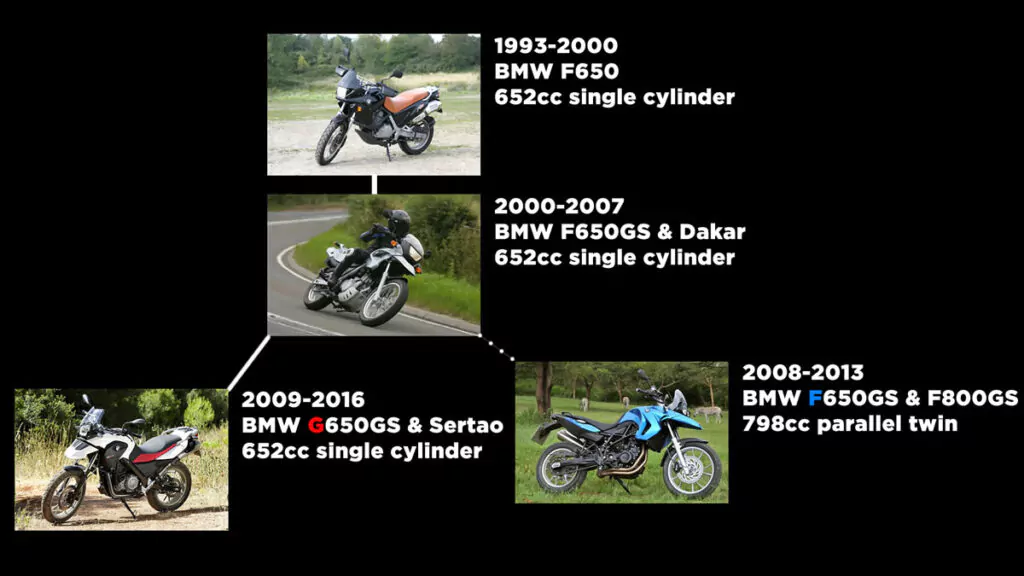
There was outcry for the old 652cc single cylinder motorcycle which was much beloved by the motorcycle community (and one of the best motorcycles of all time in my opinion). As a result, in 2009, in BMW introduced the G650GS and G650GS Sertao. These 652cc single cylinder motorcycles took the place of the original F650GS and F650GS Dakar single cylinder motorcycles, but with a new more modern look and updated features.
In 2014, BMW introduced the BMW F700GS which would replace the F650GS and added a few more standard features you can read about here.
Is the BMW F650GS easy to ride?
The BMW F650GS handles very easily because BMW has been perfecting the GS for decades now, since the F650 first came out in 1993. A big reason for the sharp handling is the 110/80-19 tall and skinny front tire. The front tire leans over easily but precisely, and pairs well with the 140/80-17 rear.
The BMW F650GS’ ease of handling is also helped by all of the small things BMW does smarter than their Japanese competitors. When you’re riding a BMW F650GS you won’t find the gas tank in front of you. BMW tucked the tank under you because they know fuel is heavy. Having weight high up a motorcycle can make it feel tipsy. By keeping the fuel tank lower, BMW makes their motorcycle lets their motorcycle handle better, without that top heavy feel. It also makes the motorcycle feel lighter than it is when you’re lifting it on to the center stand, or pulling it off of the side stand.
Making the motorcycle feel lighter is also helpful on a long day’s ride. After hours of riding through the wind, fatigue can really start to kick in, and having a motorcycle that doesn’t feel as heavy can really help avoid feeling of fatigue and sloppy handling.
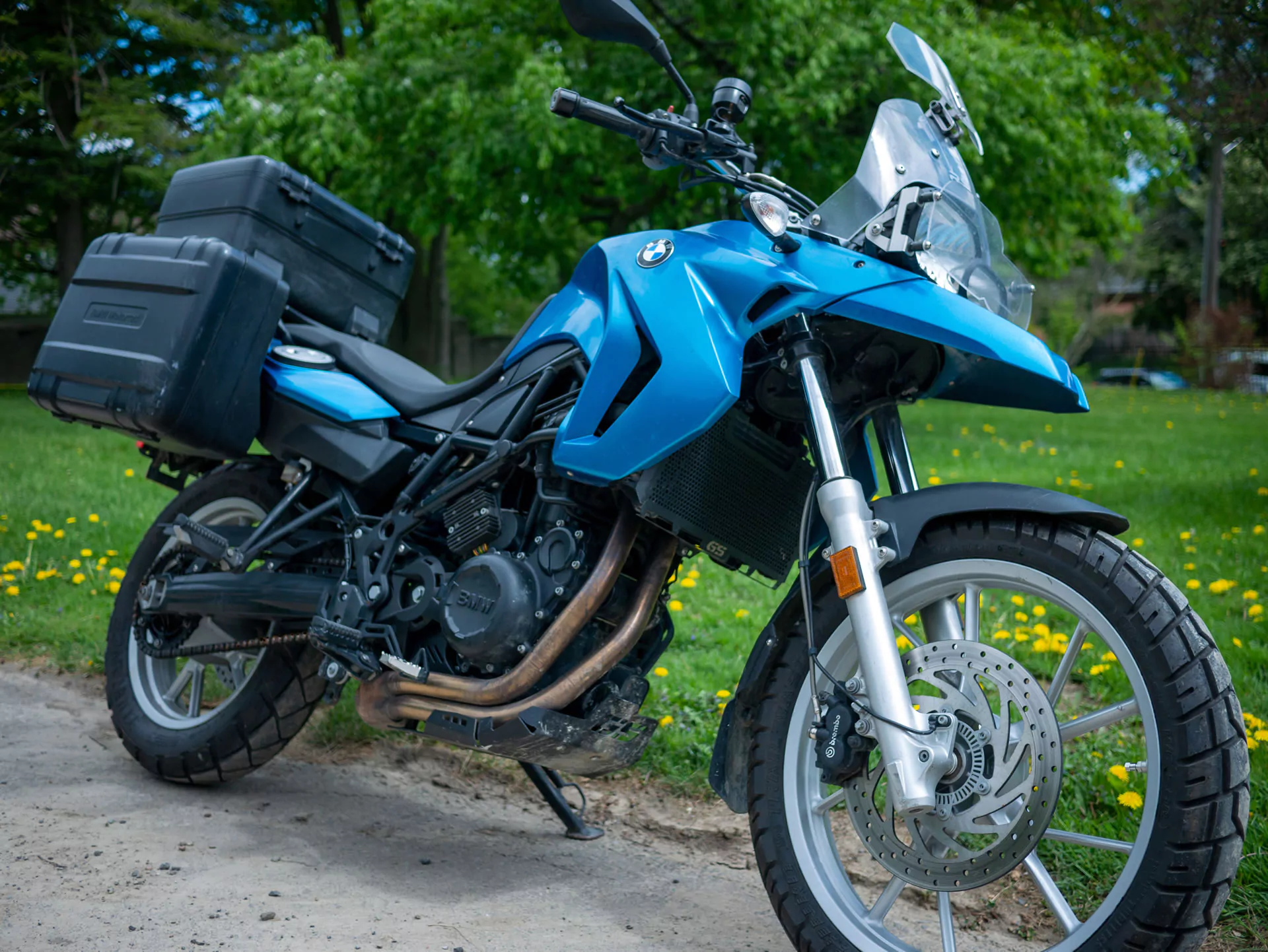
Is the BMW F650GS good for short riders?
You’ll find many factory-lowered BMW F650GS motorcycles and they are perfect for shorter riders. A lowered BMW F650GS will have a seat height between 28″ to 29″. A seat height that low is pretty amazing in the adventure/dual-sport motorcycle segment. For the sake of comparison, a Harley-Davidson Low Rider has a 27″ seat height.
At about 5’11”, I found the lowered F650GS to feel a bit too low for my personal preferences. Newer riders might prefer the confidence that comes from being able to get your feet firmly planted on the ground beneath you in case you start to tip over. At the time of writing this review I’ve been riding motorcycles for over 15 years and on this style of motorcycle I’d prefer the extra room for my legs and a little extra ground clearance too. For shorter riders who can handle a 28″ to 29″ seat height, you’ll be very happy on an F650GS twin.
Can the BMW F650GS go off-roading?
The BMW F650GS can absolutely go off-roading, however if you’ll be doing a lot of off-roading you might want to look at a BMW F800GS instead. If you’re only going to be doing mild off-roading, and you equip your BMW F650GS with proper off-road tires, you’ll have a good starting point. Just remember, most dirt bikes are much lighter and much smaller, so you should set your expectations accordingly.
The BMW F650GS does not have traction control, but it comes with ABS which you can turn on and off. There are tons of aftermarket goodies for this motorcycle including many aimed at off-road riding enthusiasts.
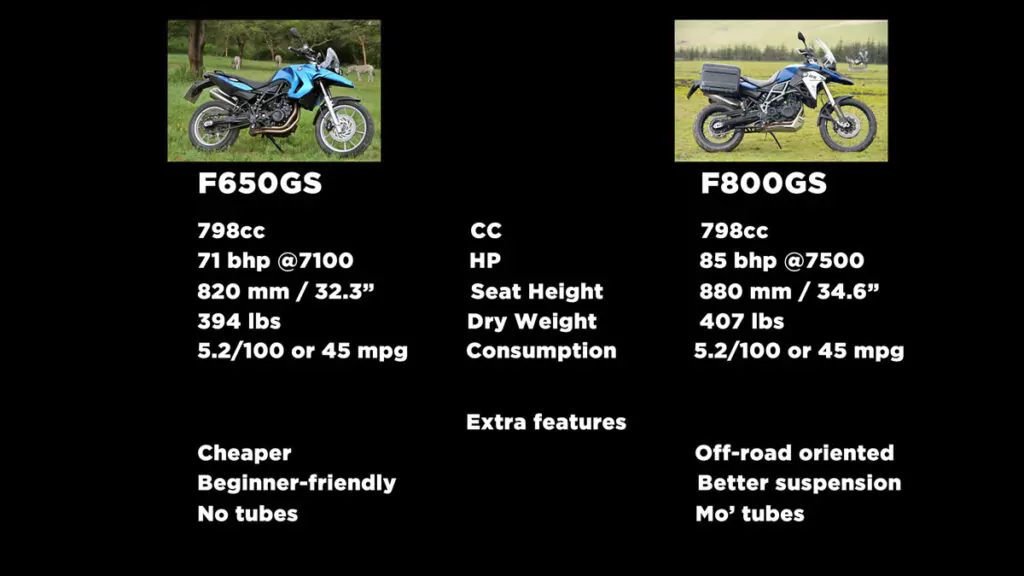
If you’re a serious off-road motorcyclist you may wish to consider the BMW F800GS. It uses roughly the same motor as the F650GS, minus a couple parts different between the two. It also features a 21″ tubed tire rather than F650GS’ 19″ tubeless tire. You’ll get much better suspension as well. All of this will come at a greater price however.
Does the BMW F650GS come with a center stand?
The BMW F650GS comes standard with a side stand and in some markets it may also come equipped from factory with a center stand as well.
The nice thing is that even if yours does not come with a center stand you can find options on Amazon or from brands like SW-Motech.
What is the fuel consumption of a BMW F650GS?
The BMW F650GS is known for fuel-efficiency. It easily averages 45 mpg, or 5.2 liters per 100 kilometers. Fuel economy is fairly consistent whether in the city or on the highway. The BMW F650GS has a 4.2 gallon (15.9 liter) gas tank so you have about 180 miles or 290 km of range.
These numbers are a conservative guess to keep you from getting stranded. If you visit Fuelly, a website where owners log and share their mileage, you’ll find the majority of F650GS owners all report over 50 mpg. That would bring your fuel range on an F650GS up to over 200 miles (322 km) which is terrific.
Can you tour on a BMW F650GS?
The BMW F650GS does a great job at touring and is very underrated for how good it is in this role. The BMW F650GS has a huge aftermarket following so you can buy all sorts of parts for it. If motorcycle touring is what your after you can easily set up this motorcycle to be perfect for you. This summer I did a 1,200+ mile (2,000 km) riding trip on the smaller G650GS and it was great. We had an upgraded seat, windshield, and luggage. You could easily do all of the same modifications on an F650GS and really comfortably ride some long days.
Part of the F650GS’ charm when it comes to touring at the motorcycle’s ergonomics. It puts riders in a position very similar to sitting at a desk, or a kitchen table. It’s a position we’re used to being in eight hours a day anyway. When paired with an upgraded windscreen, and a more comfortable seat, this is a great touring motorcycle. The 798cc motor has no issue producing power, even on the highway, as the motorcycle makes 71 horsepower. You could ride it up to 115 miles per hour (185 km/hr). You wouldn’t want to, but it’s good to know that the motorcycle makes enough power to pull away from trouble should you ever need to.
It also comes with Anti-Lock Braking System and heated grips from factory. That’ll help to keep you safe, and also help to keep you warm, in a wide variety of temperatures. If you hold both the right and left turn signals at the same time, you’ll activate a four-way flasher/hazard light function. Another nice touch from BMW.
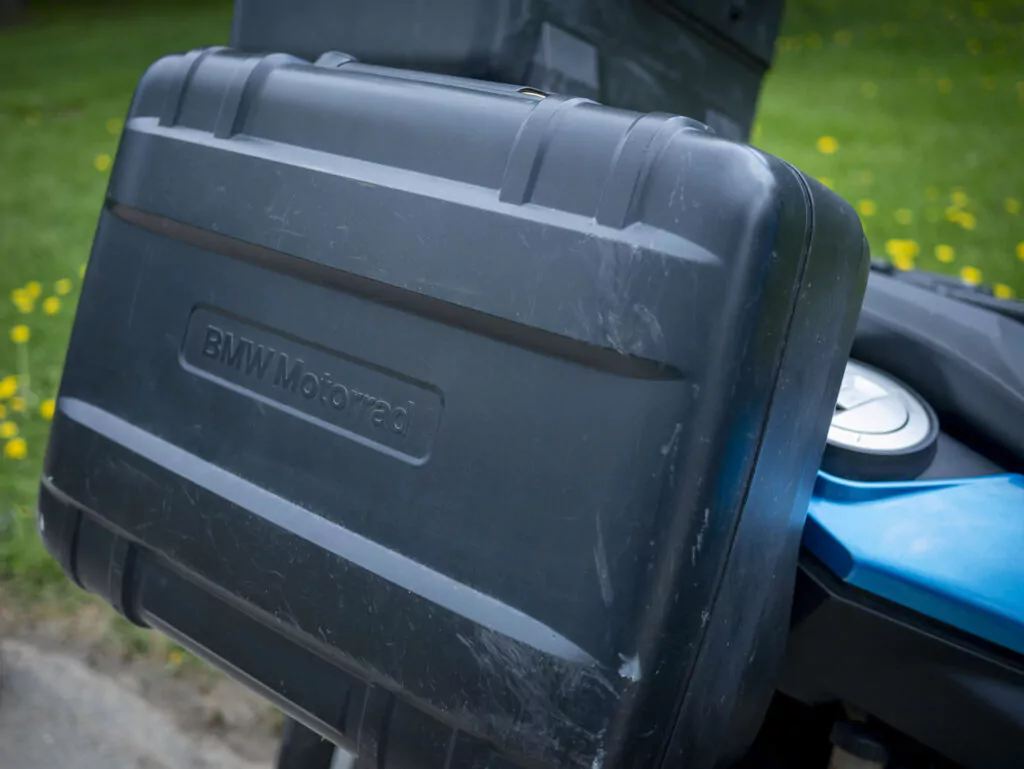
What luggage can you put on a BMW F650GS?
The BMW F650GS doesn’t come with luggage, but you have a huge variety of options you can mount on the motorcycle. Motorcyclists who do a lot of off-road motorcycle riding tend to prefer soft bags as opposed to hard cases. Soft saddle bags mean that if the motorcycle falls over off-road, the bag will not break. A rider with hard plastic side cases may not be as lucky.
Personally, I do little to no off-roading, so I prefer hard cases. I like my hard saddlebags because I can lock them up when I leave the motorcycle unattended and they’re harder to break into. I also like that they’re easier to off the motorcycle and bring into a hotel room with me when I’m on the road or just going out to run errands.
The bags equipped on this F650GS are BMW’s own Vario cases. The Vario cases look great because they come really close to the motorcycle which is more aesthetically pleasing. They also offer more storage space without having to stick out too far off the motorcycle. They’re also really special and unique because they are a hard case, but they’re also expandable. There is a lever mechanism inside of the case which expands or contracts the top case, depending on how much gear you need to bring with you. The Vario cases can also be left locked or left unlocked, and are easy to mount and remove in just a few seconds. They also feature a little briefcase-style holder to make carrying the cases away easy and comfortable.
On my BMW G650GS I use Givi cases which I bought used for very cheap. They aren’t as fancy as the BMW ones, but Givi cases are still of excellent quality and can be found second hand at great prices often enough.
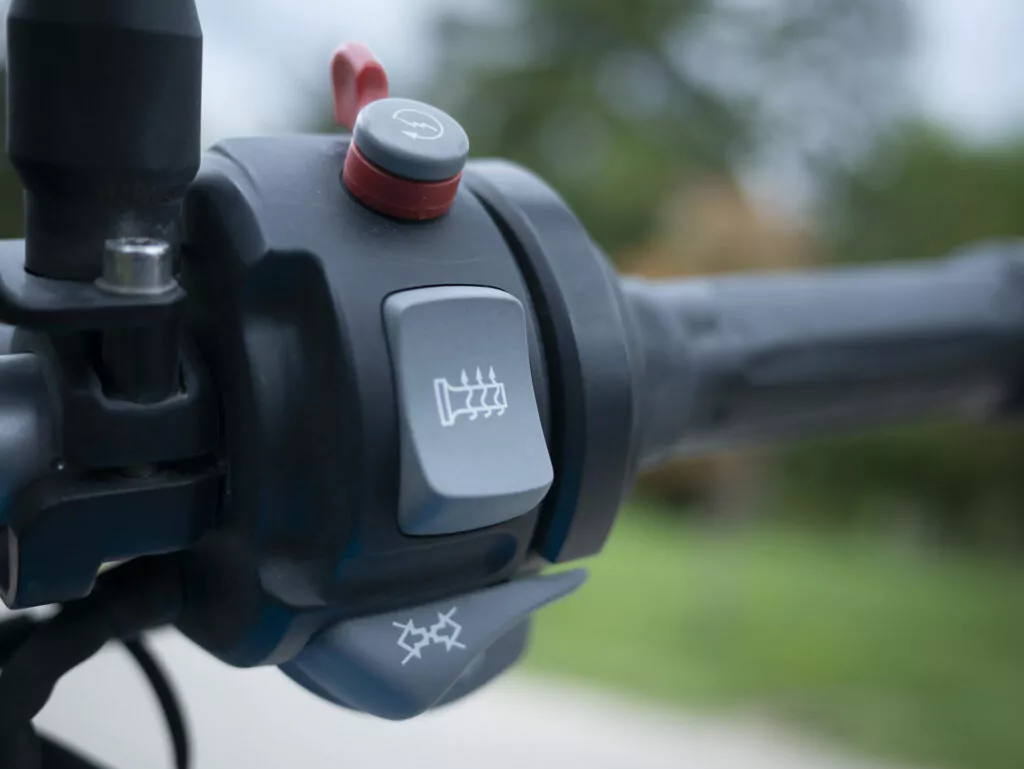
What do I dislike about the BMW F650GS?
I really can’t stand the turn signal switches on this motorcycle. BMW isn’t afraid to try new and different things, but sometimes they make mistakes along the way. Unfortunately the F650GS suffered from one of these mistakes.
You operate a traditional motorcycle turn signal switch with your left thumb only. You can move your thumb left, right, or in, to activate or deactivate the signals. BMW went in a different direction on this motorcycle. They used a three switch setup. One switch (left hand) for activating your left turn signal. One switch (right hand) for activating your right turn signal. Another switch (right hand again) for turning off either turn signal. If you want to turn right, you’ll have to use your right thumb to activate your signal. If you want to turn off your turn signal, you’ll have to use your right thumb to hit the cancel button. Even worse is that if you turn left, using your left thumb, you’ll still have to use your right thumb to turn the light off after you make your turn.
In stop and go downtown city traffic, I am constantly needing to indicate my lane changes and turns, and I want my right hand to be dedicated to my throttle and front brake only. These are very important parts of motorcycle riding. I don’t want my right hand to have two more jobs to do.
Other then this the only other thing I dislike about the BMW F650GS is the lowered model is just too low for my tastes. That’s why I sold it and bought an F700GS when my friend told me she was selling hers.
What’s the difference between the F650GS and the F700GS?
The F650GS and F700GS motorcycles are largely the same motorcycles. The F700GS gets a few improvements including an additional front brake and electronically adjustable suspension. I did a whole article and video on the two motorcycles and why I bought them both and their differences and similarities here:
I hope I’ve answered as many questions as possible about the BMW F650GS twin. If you’re thinking about buying one with low milage, I strongly recommend it. They’re fantastic, reliable motorcycles that are easy to ride, very practical, and make you want to go out on an adventure.
If you’re looking at an F650GS and you aren’t sure if it’s a 652cc single or one of the newer 798cc parallel twins, just check out the year in the advertisement. If there is no year in the ad, just count the number of exhaust headers coming out of the front of the motor. Speaking of exhausts, here’s what this motor sounds like with an Akrapovic slip on exhaust.
You can always leave me a question or a comment. I’d love to hear what you have to say.
 YouMotorcycle Motorcycle Blog – Motorcycle Lifestyle Blog, MotoVlog, Motorcycle Reviews, News, & How-Tos
YouMotorcycle Motorcycle Blog – Motorcycle Lifestyle Blog, MotoVlog, Motorcycle Reviews, News, & How-Tos
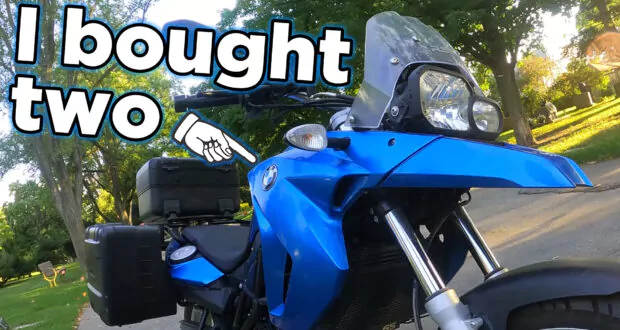
Just got mine! First ride was in the pouring rain on the CA 5 freeway, and I couldn’t believe how stable the bike is in the wind and rain! Honestly, feel safer on this in the elements than any other I’ve ever ridden.
Absolutely love mine! Owned it since 2014, took it on a killer camping road trip, covered almost 3000km. It’s also my daily ride to work and back. Best bike I’ve had so far
Mate, love this video and this bike. Just sold my Honda CBF600, and now I’m in the market for the next ride. Gonna test a bunch, but seriously considering the f650gs. Fuel tank under the seat, not-so-top-heavy feel, seems like major advantage (in my eyes). Fingers crossed!
Hey there! Thanks for the video. Question for you, as you have both models at home: Can I install a crashbar designed for the F700GS onto the F650GS? Wondering if the two bikes have the same structure. Appreciate your work on this channel!
Yup, absolutely, they are 90% the same motorcycle. I went the opposite route and took the crash bar off the F650GS and put it onto the F700GS.